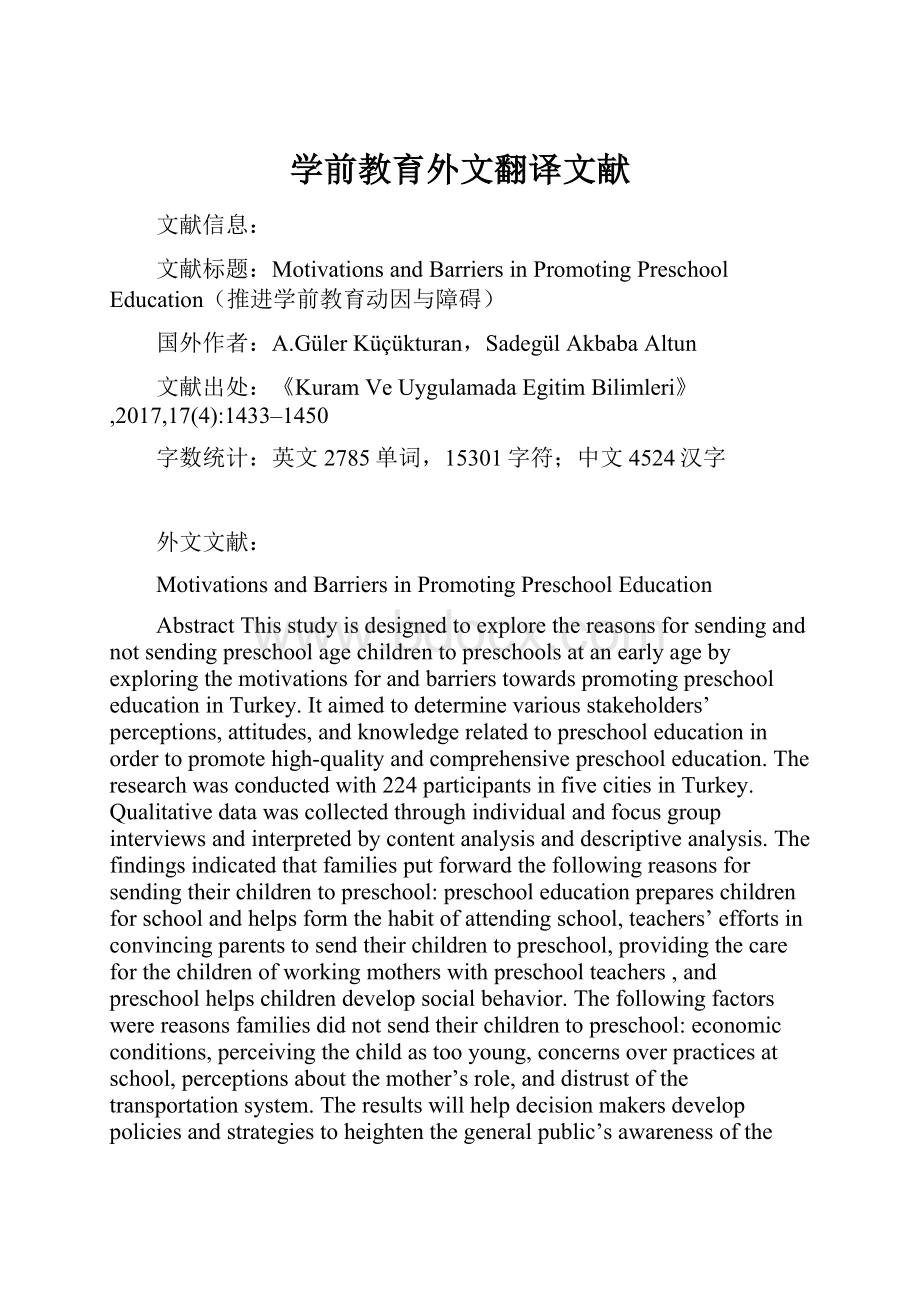学前教育外文翻译文献.docx
《学前教育外文翻译文献.docx》由会员分享,可在线阅读,更多相关《学前教育外文翻译文献.docx(14页珍藏版)》请在冰豆网上搜索。

学前教育外文翻译文献
文献信息:
文献标题:
MotivationsandBarriersinPromotingPreschoolEducation(推进学前教育动因与障碍)
国外作者:
A.GülerKüçükturan,SadegülAkbabaAltun
文献出处:
《KuramVeUygulamadaEgitimBilimleri》,2017,17(4):
1433–1450
字数统计:
英文2785单词,15301字符;中文4524汉字
外文文献:
MotivationsandBarriersinPromotingPreschoolEducation
AbstractThisstudyisdesignedtoexplorethereasonsforsendingandnotsendingpreschoolagechildrentopreschoolsatanearlyagebyexploringthemotivationsforandbarrierstowardspromotingpreschooleducationinTurkey.Itaimedtodeterminevariousstakeholders’perceptions,attitudes,andknowledgerelatedtopreschooleducationinordertopromotehigh-qualityandcomprehensivepreschooleducation.Theresearchwasconductedwith224participantsinfivecitiesinTurkey.Qualitativedatawascollectedthroughindividualandfocusgroupinterviewsandinterpretedbycontentanalysisanddescriptiveanalysis.Thefindingsindicatedthatfamiliesputforwardthefollowingreasonsforsendingtheirchildrentopreschool:
preschooleducationprepareschildrenforschoolandhelpsformthehabitofattendingschool,teachers’effortsinconvincingparentstosendtheirchildrentopreschool,providingthecareforthechildrenofworkingmotherswithpreschoolteachers,andpreschoolhelpschildrendevelopsocialbehavior.Thefollowingfactorswerereasonsfamiliesdidnotsendtheirchildrentopreschool:
economicconditions,perceivingthechildastooyoung,concernsoverpracticesatschool,perceptionsaboutthemother’srole,anddistrustofthetransportationsystem.Theresultswillhelpdecisionmakersdeveloppoliciesandstrategiestoheightenthegeneralpublic’sawarenessoftheneedforearlyeducation,aswellasbetterprovideearlyeducationopportunities.
Keywords:
Preschooleducation;Motivation;Barrier;Pre-schooling;Disseminationofpreschooleducation
Introduction
Researchiswellestablishedinshowingthataccesstoahigh-qualityearlychildhoodeducationhasadirectandpermanenteffectateverystageofhumandevelopment(Avila&Baldwin,2007;Barnett,2008;Blau&Currie,2005;Heckman&Masterov,2007;Reynolds,1992;Reynolds,Mehana,&Temple,1995).Forthisreason,inordertoprovideearlyeducationpolicies,countriesdeterminetheirequalityinopportunitypoliciesandformnewstrategies.Manycountriesregulatetheirearlychildhoodeducationpracticesthroughthestatelegislatureandaspartoftheeducationsystemaccordingtothesocio-politicaldevelopmentsofthecountry.Theselegislativeregulationsdeterminebasiccorevaluesinareaslikecurriculum,institutionalprocess,teachereducation,personnelrequirement,monitoringandfinance,andparent-teachercooperation(Banković,2014;Karila,2008;Kuisma&Sandberg,2008;Sheridan,Williams,Sandberg,&Vuorinen,2011).
Likewise,preschooleducationandthepreschoolteachertrainingsystemhavebeenchangedanddevelopedinTurkey.Eventhoughkindergartensopenedbefore1908,theybecameorganizedandwidespreadfollowingtheTemporaryPreschoolLawdated23September1913.Aftertwoyears,theLawPrimaryschoolbylawswereissuedin1915.
Accordingly,kindergartenswereopened,whetherattachedorunattachedtoprimaryschools,inordertoprovideeducationforchildrenagedfourtoseven(Akyüz,1989;Cicioğlu,1989).Withtheopeningofkindergartens,theneedfortrainedteachersintheseschoolsarose.Inthesameyearastheissuanceofthebylaws,akindergartenteachereducationschoolprovidingoneyearofeducationwasopenedinIstanbul,butitwasclosedafterfouryearsofoperationin1919.Inthisperiod,370preschoolteacherswereeducated(Oğuzkan&Oral,1987)andpreschooleducationtookitsinstitutionalplaceintheeducationprocessinrealterms.
However,formanyyears,theinsufficientqualityandquantityofearlyeducation,thechangingpositionofwomenwithinthefamilyandtheiractiverolesinreallifeduetorapidsocio-culturalandeconomicalchanges,and,mostimportantly,thepositiveimpactofearlyeducationonachild’sdevelopmentasprovenbyeducationalstudiesandbrainsurveysdemonstratethenecessitytotakecertainmeasuresintheearlystagesofcareandeducationofchildren.
Earlyeducationgainedfunctionalitywiththe“PreschoolCurriculumandRegulations,”“TemporaryTeacherTrainingRegulation,”and“PreschoolRegulation,”allofwhichwereissuedin1952andcoverthevoluntaryeducationprocessforstudentsnotatelementaryschoolage.Today,earlyeducationisgivenbytheMinistryofNationalEducation,MinistryofFamilyandSocialPolitics,MinistryofLabor,Universities,andvoluntaryagenciesinkindergartens,implementationclassrooms,nurseries,anddaycarecentersforcareandeducationalpurposes.Thismulti-headedstructurepreventseducationfromreachingitsdesiredqualitylevel.
EducationalprogramsforearlyeducationwerepreparedbytheMinistryofNationalEducation(MoNE)andBoardofEducationinordertogivehigh-qualitytrainingtoteachers.Programdevelopmentsweremadeatvarioustimestotroubleshootandpracticenewapplicationsthatwerepresentedbyscientificstudies.Accordingly,currenteducationprogramswereupdatedundertheEducationofEarlyEducationStrengtheningProjectthatwasintroducedbytheMinistryofNationalEducation,financedbytheEuropeanCommunity,andtechnicallysupportedbyUNICEF.Currently,appliededucationprogramsarepreparedseparatelyfor0–36monthsoldandfor37–72monthsold.AneducationalapproachbasedontheDevelopmentalAppropriateProgramisadopted.Inthisapproach,itisessentialtoconsidertheactiveparticipationofthechildandthefamily,suitabilityoftherequirements,andenvironmentalproperties.Thus,itaimstoraiseachild’sbehaviorsinalldevelopmentareastoahigherlevelbymeetinghisrequirementsandsupportinginteractionswitheachotherinhisdevelopmentareas.Teacherswhohavegraduatedfromtheundergraduateprograminearlyeducationfromfacultiesofeducationareresponsiblefortheimplementationofthisprograminthepreschooleducationinstitutes.Trainingisgiveninseparateclassrooms,formedaccordingtotheirages(3,4,and5).Classesarecomposedof20–24groupsofchildrencomposedequallyofeachgender.
WhenthecurrentstructureofeducationinTurkeyisassessedintermsofprogram,equipment,andteachereducation,itappearsthattheyhaveseveralcharacteristicsincommonwithEUandOECDmembercountries.However,eventhoughthestartingageforearlyeducationinOECDcountriesvaries,ifearlyeducationisevaluatedintermsofschoolingrates,71%ofthree-year-oldchildrenand86%offour-year-oldchildrenparticipatedinthisnon-compulsoryeducationin2014.Theparticipationoffour-year-oldchildrenat94%wassignificantlyhigherin2016.Atleast90%ofchildrenagedthreetofourwereenrolledinearlychildhoodeducationinOECDcountries—suchasBelgium,Denmark,France,Germany,Island,Israel,Italy,Norway,Spain,andSweden—andinmostoftheOECDcountrieshavefullenrollmentinECECforfiveyearolds(OrganizationforEconomicCo-operationandDevelopment[OECD],2016).Eventhoughthetargetedschoolingrateissetto50%forthreetofive(37–72months)yearsofageand100%forfive(60–72months)yearsofageintheNinthDevelopmentPlanfortheyear2013anddespitealltheeffortsforpromotingpreschooleducation,atthebeginningoftheacademicyearof2015/2016theschoolingrateforTurkeyis11.74%forthreeyearsofage,33.56%forfouryearsofageand67.17%forfiveyearsofage(MEB,2015).Theseratesindicatethatthedesiredandtargetedlevelsinearlyeducationhavenotyetbeenmet.
However,thistransitionisnotalwayssmoothandfastinnatureformajorstakeholders,whoincludepreschoolagechildren,theirfamilies,teachers,mukhtars,prayerleaders,representativesoftheBoardofNationalEducation,municipality,andwritten/visualpress.Inordertopromotepreschooleducation,itisimportanttodeterminehowthosestakeholdersperceivewhattheirownattitudesareandwhattheythinkofnotsendingchildrentopreschools.Inaddition,inordertoincreaseschoolingratestoacceptablelevelsatthepreschoollevel,itiscrucialtodefineandunderstandthecontextthatpolicymakersdealwith.
Therefore,thisstudyhasbeenconductedtodeterminethestakeholders’motivationsforsendingornotsendingtheirchildrentopreschooleducation.Theresultsmayinformdecisionorpolicy-makersatalllevelsastheydeveloppoliciesandstrategiestoincreasethegeneralpublicawarenessoftheneedforpreschooleducation,aswellasprovidepreschooleducationopportunitiesbyincreasingawarenessabouthowdifferentstakeholdersperceivepreschooleducation.
Method
Thisstudywasdesignedasaqualitativecasestudyinordertoexplorethereasonstheparticipantsconsideredinsendingornotsendingtheirchildrentopreschool.Casestudiesareusedfordescribinganinterventionorphenomenonanditsreal-lifecontextwhenposingquestionslike“how”or“why”(Yin,2003).
Participants
Thesamplingprocessincludedcriterionandmaximumsamplingprocedures(Patton,1990).Variablesincludinggeographicalregions,migrationpatterns(incoming-outgoing),andschoolingrateswereconsideredthemainfactorsaffectingpreschooleducationattendance;therefore,basedonthesecriteria,fivecitiesweredetermined.Whenselectingtheparticipants,itwasalsoensuredthatbothruralandurbansettlementswererepresented.Finally,atotalof224participantsrepresentingparents,preschoolteachers,preschoolstudents,imams(prayerleaders),mukhtars(headofvillageorneighborhood),andbranchdirectorsofprovincialnationaledu